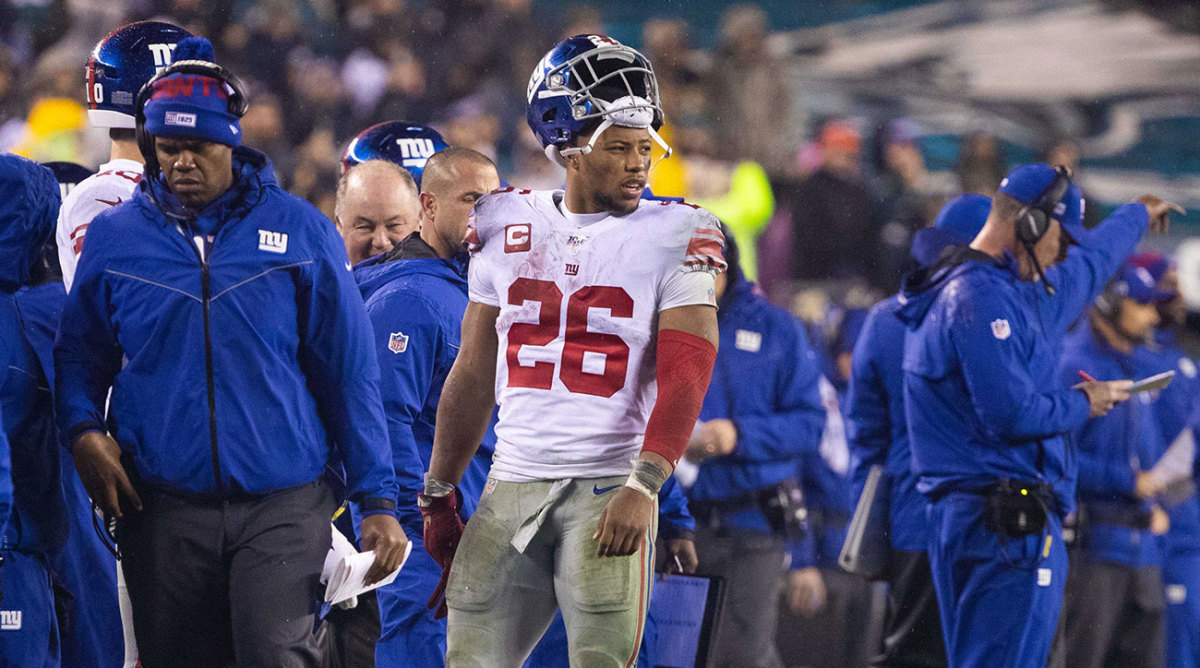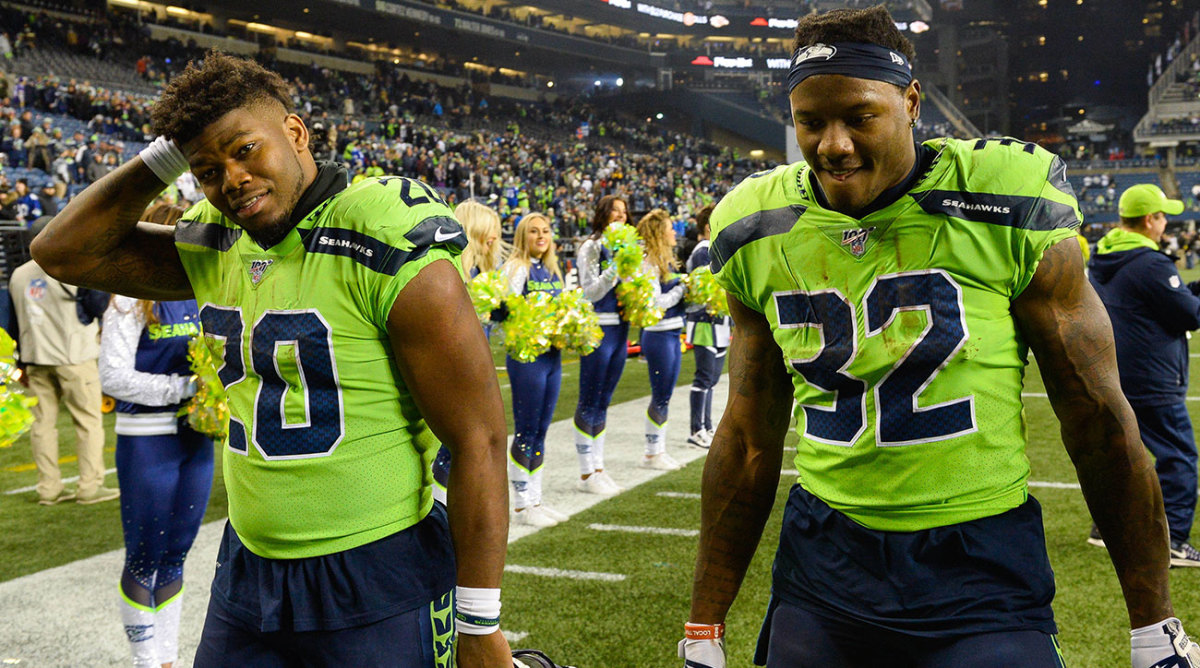The Worst Part of Fantasy Football? Running Backs Are Still King. Let's Fix That
Dave Gettleman is the last general manager to select a running back in the top five in the NFL draft. In this case last means both that he is the most recent to do it, and that no one else will ever do it again. Should Big Blue continue to struggle, and Gettleman be fired as a result, that’s nothing to be celebrated. But, boy, would we have a new pastime for him.
Fantasy football is the last bastion for those who value running backs above all other positions. Is it too much to ask the strategies for building a fantasy roster even loosely resemble those of the NFL?

Back in the 1980s, when fantasy football first took root, running back supremacy was fine, because NFL offenses revolved more heavily around the ground game. But by the 1990s sophisticated passing offenses began to take over, and the NFL adjusted its rules to encourage teams to take to the air. First, officials began flagging defensive backs for thought crimes on receivers, then they made it illegal to hit quarterbacks above the top of the navel, and then below the bottom of the navel, and then at all, particularly hard. The result has been a steady trend of pass-happy systems, with quarterbacks increasing in value exponentially for real-life teams. Running backs, meanwhile, are now more replaceable than ever. Look at the recent holdout of Melvin Gordon. The Chargers pretty much said, “Yeah, instead of paying you, we’ll just play the backup.”
And it worked! Really well!!
But fantasy football is, like an obsessive fan of Stranger Things, stuck in the ’80s. It's a fine show, perfectly enjoyable, but I mean... Anyway, running backs are still king, dominating the first rounds of the draft, while taking a quarterback early is a way to spot a fantasy rube.
Together, we can flip the equation to move fantasy quarterbacks’ value closer to what it is in real life. All it requires is a couple of scoring altercations that are not particularly radical. After all, no one wants to be in a league where the owner drafting first takes Patrick Mahomes, the next one picks Lamar Jackson—and everyone else curls into the fetal position and softly weeps. But there’s no reason quarterbacks should be the fantasy-football equivalent of punters, for goodness’ sake.
Before we get into my proposals, understand the mathematics currently at work. Assessing a player’s worth in fantasy is all about value over replacement. If we lived in a world where 60 running backs averaged between 20 and 25 fantasy points per game, running backs wouldn’t be as valuable because everyone would have good ones. But we don’t. In standard 12-team, half-PPR leagues last season that started two running backs and a flex, the gap between the top running back (Christian McCaffrey) and the top nonstarting RB (Kareem Hunt) was 15.3 fantasy points per game. Meanwhile, the gap between the best quarterback (Jackson) and the 13th-best QB—essentially, the top “replacement-level” QB (Kyler Murray)—was only 9.9. And that QB gap is as large as it is only because of Jackson’s historic year. If you dull the Lamar factor by taking the average of the top three QBs, the gap between them and the top replacement QB is 5.7 points per game. For the top three running backs, it’s 10.9.
My first proposed change is a no-brainer: Increase the value of touchdown passes to six points. (“Four points per TD pass” is arbitrary at best and the unhinged rantings of a mad man at worst.) This change gives quarterbacks’ value a boost, but only a slight boost, because TD totals are relatively consistent among the top QBs. A six-point TD moves the value-over-replacement for Jackson (from 9.9) to 11.8 fantasy points, still nowhere near McCaffrey’s 15.3.
The next change is more critical: Start only one running back. For the love of James Develin, no NFL team is lining up two tailbacks in the same backfield, so why are we doing it in fantasy football? Taking away the second running back also allows you to eliminate the flex, which Zeus brought into existence only to make for an even number of starters for the sake of snake drafts. Start three receivers, which most NFL teams do anyway, as well as a tight end. Better yet, allow the option of starting two receivers and two tight ends. (If you're scoring at home—and I know you are—that makes for a starting lineup of QB, RB, WR, WR, TE, WR/TE.)
In this scoring system and lineup configuration, the value over replacement for McCaffrey falls to a much more reasonable 12.7 points per game. Running backs are still king, but now QBs have at least pulled almost even.
You’re going to argue that in Mahomes’s 2018 season, using six-point TD pass scoring would have ruined a league. (I’d argue that it should have—in reality, he was the best player in football by an obscene margin.) But in reality, the gap between Mahomes and the top replacement-level QB was 10.15 points per game that year, still less than top RB Todd Gurley’s VORP of 10.29.

If math isn’t enough for you, here’s an obvious added bonus: You’ll get your Sunday mornings back. Remember Sunday mornings? You would have liked to have spent that time playing with the kids, cleaning up the yard, or perhaps going to your house of worship. But instead you were hunched over a screen, bowl of Mueslix in hand, trying to decide between Royce Freeman and Rashaad Penny at RB2 for a bye-heavy week. There aren’t that many running backs in the NFL with significant roles. Eliminate the RB2 and you will be free of this torture.
You will also be doing your part to move fantasy football into the 21st century, even if it means Dave Gettleman will never join your league.
This story originally appeared in SI's fantasy football preview issue, available on newsstands now. Check out SI Fantasy for more fantasy football coverage. For those leagues not following Gary's advice, we recommend Five Mid-Round Value Running Backs with Early Round Upside and Five Late-Round Running Backs to Target in Fantasy Drafts.
• Question or comment? Email us.
